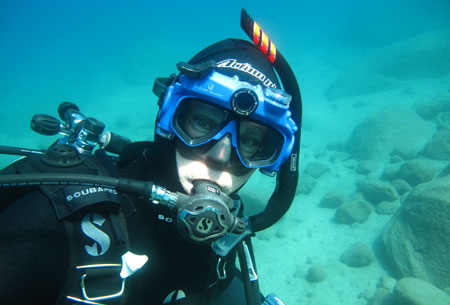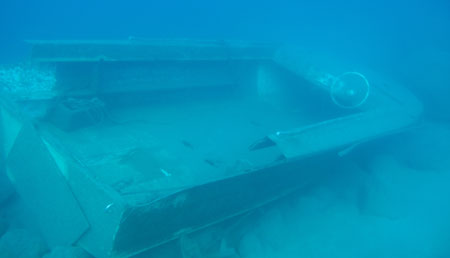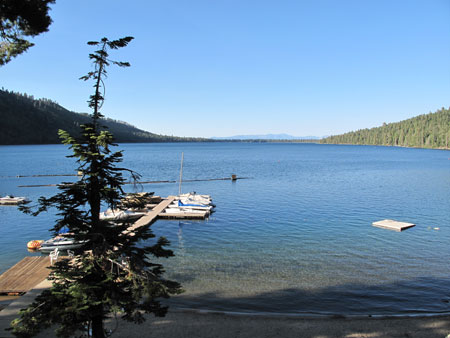« August 2009 | Main | November 2009 »
September 20, 2009
Fallen Leaf Lake
When I talk about diving Lake Tahoe or other local venues, people inevitably ask about the water temperature, which is usually in the mid to high 60s in the summer and late summer. That's apparently too cold for many divers to even consider. That's unfortunate as they are missing out not only on some good diving, but also on the adventures that come with each and every dive trip. I thought of that again after spending an unforgettable day diving Fallen Leaf Lake near Lake Tahoe.
 The water level at Fallen Leaf Lake, whose name originates from an Indian legend, is at about 6,370 feet, as mentioned in a prior entry. There isn't much information on the lake itself, though American nature writer and lecturer George Wharton James described the area in "The Lake of the Sky," published around 1915 (where he describes the water level as being 6,300 feet, 80 feet higher than Tahoe). A small dam was built in 1934 and some sources refer to the lake as a reservoir, although the water level appears to be constant. Despite Fallen Leaf Lake's proximity to Lake Tahoe and Route 89, it's a remote area where a very narrow and only marginally paved road leads part-way around the lake. There are small (albeit very expensive) cottages along the east side of the lake, and the tiny community of Fallen Leaf at the south end has a post office, but it's only open a few months of the year as is the one and only shop.
The water level at Fallen Leaf Lake, whose name originates from an Indian legend, is at about 6,370 feet, as mentioned in a prior entry. There isn't much information on the lake itself, though American nature writer and lecturer George Wharton James described the area in "The Lake of the Sky," published around 1915 (where he describes the water level as being 6,300 feet, 80 feet higher than Tahoe). A small dam was built in 1934 and some sources refer to the lake as a reservoir, although the water level appears to be constant. Despite Fallen Leaf Lake's proximity to Lake Tahoe and Route 89, it's a remote area where a very narrow and only marginally paved road leads part-way around the lake. There are small (albeit very expensive) cottages along the east side of the lake, and the tiny community of Fallen Leaf at the south end has a post office, but it's only open a few months of the year as is the one and only shop.
Remote though the area is, it has an amazing history. In 1863, a man by the name of Nathan Gilmore discovered mineral springs a couple of miles west of Fallen Leaf, just past a tiny body of water now known as Lily Lake for the water lilies on it. Gilmore eventually built a wagon road from Fallen Leaf Lake, set up a summer camp and log home so he could bottle and ship the carbonated water from the spring, and by 1880, "Glen Alpine Springs" had become a resort. By 1910, the resort, which now even had a post office, could be reached by automobile (it can't anymore). In the 1920s, noted architect Bernard Maybeck designed no fewer than 20 buildings for Glen Alpine Springs, though only six were ever built. The resort was open until the mid-1960s, then eventually became a Federal Historical District.
Today you can drive up to Lily Lake on an impossibly narrow mountain road where you literally have to get off the road if someone comes at you. At Lily Lake there is a small, tidy parking lot nestled into the terrain. There are only about 20 very tight spaces, and if those are taken there is nowhere to go and you have to return. Some sort of "Lot Full" notification system would greatly reduce traffic to and from the area. Anyway, the views around Lily Lake are spectacular and, in my book, compare favorably even with Yosemite, especially if you factor in the complete absence of Yosemite's crowded tourist atmosphere. From Lily Lake it is a short one-mile hike to Glen Alpine Springs, which we didn't do as we got there after our dive when it was already getting late.
But to the diving itself. We parked at the lot by the Fallen Leaf store (and Post Office when it is open) and carried our gear down to the boat ramp. You can unload down there, too, but then have to move the car back up on the lot. It was a beautiful mid-September day with the temperature in the low 80s, and the water a nice 67 degrees on the surface. This was going to be not only our first dive in Fallen Leaf Lake, but also the first with our new Uwatec Galileo Sol dive computers.
The water looked absolutely gorgeous, but as soon as we got under it became apparent that this was not an ideal dive site. The beach instantly falls off at an almost 45 degree angle (James had indicated a depth of 380 feet in his book). The bottom is all silt and gets stirred up if you so much as whirl a fin within two or three feet or so. Once we got underway we found ourself at a depth of almost 60 feet just a few dozen feet away from shore. The water temperature quickly dropped, too, and there was one of those massive thermoclines you can actually see as optical distortions, as if the water were some gelatinous mass. Visibility wasn't nearly as good as I'd expected and it was already getting darker. The steep, featureless silty slope made me feel somewhat disoriented and I also found that I could not easily see the very detailed display of my new Galileo.
We slowly made our way along the slope, ascending to about 30 feet where we found all sorts of discarded beer bottles and soda cans (including a special bi-centennial one from 1976) but not much else. There was driftwood and a few massive tree trunks, but overall it was quite uneventful. Between having to constantly try not to stir up silt while looking for things and the steep slope, I never really got into it, although we actually stayed down for a full hour. Carol emerged with two baskets full of cans and bottles and other assorted trash (though it really wasn't bad at the bottom), and I went up to take my gear off and bring the car down to the dock.
The Fallen Leaf store makes decent burgers and chicken strips (and serves nice, big portions of ice cream), and so we munched on those on the establishment's veranda overlooking the lake. We then made our way up to Lily Lake, taking in the breathtaking vistas.
Even though the dive itself wasn't spectacular, we spent a wonderful day exploring, seeing new things, discovering nature, and realizing once again that you really don't have to travel far to see great things and have a wonderful time. The Sierra Nevadas are spectacular, and diving in some of those lakes is not only an adventure, it is also absolutely free.
Posted by conradb212 at 4:09 PM
September 8, 2009
Tahoe and Fallen Leaf Lake
I've been meaning to dive Lake Tahoe again ever since late Spring, and here it is September again before I actually got around to doing it. Tahoe is only an hour and a half from my house, max, and I should take advantage of going up there much more often, even if there really isn't much to see in the lake. But the breathtaking scenery up there alone is worth a trip, and the water is cleaner and clearer than almost anywhere.
So once I got my dive computer back from Scubapro and my gear was back from the annual service, there really weren't any more excuses to put off a day trip to Tahoe, especially since we wanted to check out our new High Pressure 100 cubic foot steel tanks. We decided on Meeks Bay on the California side of the lake because of its easy access. I prefer the Rubicon site at D. L. Bliss state park, but hefting equipment down from the parking lot to the little beach there is just brutal, and getting it back up even more so. So Meeks Bay it was, and it's always nice there.
We went on a Friday and, worrying about having to hunt for a parking spot with the pre-Labor Day crowd, tried to get there bright and early. It got to be 10AM anyway, but our fears were proven wrong; not a car in the lot and we had the beach pretty much to ourselves. It was a gorgeous day but, this being early September, it was quite fresh and so we waited for the sun to warm things up a bit. The water seemed in the mid to high 60s as it usually is in late summer at Tahoe.
After half an hour or so two more divers arrived and we got to talking as we donned our gear. They were old friends and career military, one an experienced diver, the other having just a few dives. I shared what I knew about Meeks Bay and the lay of the land. We took our time and they were in first. Our new Steel 100 tanks made a good first impression. They had the same circumference as the standard Aluminum 80s we had used in Turks and Caicos, and so there was no need to adjust the tank straps on our BCs. And though they were quite a bit taller than Carol's smaller steel tanks, they were lighter and handier than I had expected. We wore 7mil wetsuits, hoods and gloves, and I decided on 14 pounds of weight whereas Carol took 12 (you need a bit more weight than you'd expect because the lower surface pressure at altitude means the closed-cell foam of the wetsuit expands).
The water was wonderfully refreshing and didn't feel cold at all. I used the Liquid Image VideoMask instead of my Scubapro Frameless. We were about ready to go when I realized that our new acquaintances had some problems. One of them was on his back and calling for help. He did not seem in imminent danger and his friend was closeby, but we hurried over there anyway. He had an asthma attack and could not breathe. He'd dropped his mask, snorkel and weight belt and we recovered that. Fortunately, the attack quickly passed, but that was it for his diving plans. It must be very frustrating to have something like that happen, but certainly better above water than during a dive.

So we finally got ready and... Carol's dive computer errored out. Its battery had been down to the mid 50%s and we had contemplated sending it to Scubapro for a battery replacement, but decided against it since it takes Scubapro weeks to get the computer back. So that came back to bite us. I got back out of the water and to the car to get Carol's backup computer. It's not air-integrated and we didn't bring along a pressure gauge, but since she uses less air than me anyway and we had two big, full 100 cubic foot tanks, we decided to go.
The water was clearer than last year, but not as clear as it had been two years ago. It actually seemed fairly murky to me, though Carol later said it'd been in the 50-75 foot range. The southern side of Meeks Bay is quite shallow for the first ten minutes of the dive or so, barely 15 feet. Then, all of a sudden, you see a steep incline and we worked our way around boulders down the slope. Within just a few minutes we were at 85 feet and I saw what looked like a man-made structure. It turned out to be the wreck of a small motorboat. I didn't want to go any deeper but Carol went down to the boat at about 100 feet and took pictures. The temperature had dropped into the 50s, but it still didn't feel cold.

The steep slope probably goes down to well over 1,000 feet and so the temptation was there to descend a bit more, but we were on Nitrox 32 with a MOD of 116 feet, there wasn't much light, and there wasn't much to see. So we did slow ascent back up to 30 feet and swam around the huge boulders, took pictures of crawdads, and looked at schools of silvery fish shooting around the rocks. Diving is always wonderful, but I really did miss all the plants and life of the ocean. Without it, there is just... nothing.
Technically, things went well. My replacement computer worked as it should, the steel tanks felt good, and I probably would have been fine with 10 or 12 pounds of weight. I had started the dive with 3,300 psi and had 1,500 psi left after a 54 minute dive. Carol started with 3,400 and ended with 2,200. So these tanks are good for two dives.
We had a leisurely lunch at Rosie's in Tahoe City, then decided to check out Fallen Leaf Lake on the way back. Fallen Leaf is just a couple of miles off Route 89 that goes along Lake Tahoe, but the lake level is at 6,370 feet, about 150 feet higher than Lake Tahoe. It's a small, longish lake maybe three miles long and less than a mile wide. The road along Fallen Leaf Lake is very narrow and barely paved, and it can be quite an adventure when someone comes at you. There isn't any public parking either, except for a few spots at the village of Fallen Leaf where we stopped and had ice cream. There's a little marina and a small public beach, and we instantly had a great desire to dive the incredibly clear lake. The guy at the boat rental place said the bottom drops off quickly, with the end of the marina already at 100 feet. It was too late in the day, though, and so we decided we'd come back some other time.

Posted by conradb212 at 2:33 AM








